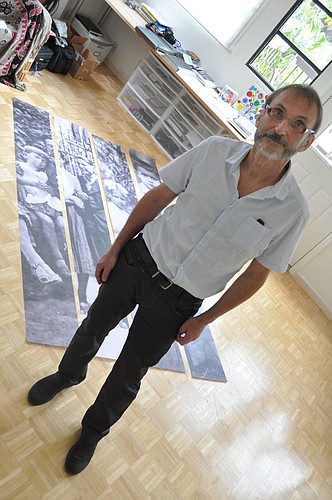- November 26, 2024
-
-
Loading

Loading

In the middle of the Cold War in 1963, artist Wojtek Sawa moved to the United States from Poland when he was 10 years old. His new American classmates believed he was from a country that had no electricity and where children were taken away from their parents and put in communist indoctrination camps. When he’d tell them it wasn’t true, they told him he had been brainwashed.
A year later, when his family moved back to Poland, communist propagandists were telling the Polish the U.S. was full of black people getting beat up by white people and that everyone was poor and needed to be sent blankets.
Sawa’s experience with negative propaganda as a young boy had a profound effect on the now 60-year-old; one that he’s carried throughout his life.
“Since then, my art has been directed at finding common ground, being aware of barriers, trying to cross them and trying to show things as they are,” he says.
Sawa is a filmmaker and visual artist who creates site- and time-specific installations that involve audience participation.
His most recent project, “The Wall Speaks,” is a based on oral testimonials of people who were children and teenagers in Poland during World War II.
“It’s not always grim,” he says. “It can be quirky and humorous and (the subjects) aren’t just stuck in the gloom of it, no matter how bad it might have been.”
The project includes film screenings of the testimonials and an installation of large-scale photographs. Sawa says these stories stem from the war’s concerted effort to eradicate the Polish, regardless of religion or status.
When a person visits the exhibit, he picks up a brick from a pile. On one side is a written historical fact about a Polish person who was hurt by negative propaganda. The attendee carries the brick throughout the viewing process to feel the weight or burden of being slandered. At the end, he is asked to contribute an inscription on the back of the brick about his personal experience with a negative stereotype. He leaves the brick behind.
Sawa began the project two years ago when a few of his friends approached him about paying tribute to their parents’ generations.
“I wasn’t particularly excited,” he says. “Then, it was an ‘old people’ project to me.”
But, after Sawa began to talk to the people featured in the project, he started to enjoy it.
He also realized that what he thought would be a compilation of the elderly’s stories turned out to be stories about children. The seniors he interviews were young during the war, and they explained their memories from a child-like perspective.
One of Sawa’s interviewees was Maciek Rubenstein. When the war started, Rubenstein was 5 years old and lived in a nice apartment building with his Catholic family. But, then, his father, who worked at a printing press, thought it would be safer if the family moved to the basement of the printing house. Although it was hot, his mother made him bring his fur coat in case they couldn’t return home before the winter. He remembers sitting on the coat as his mother told him, “Don’t forget your fur coat!” right after a bomb went off. He also remembers, and finds ironic, that his family’s apartment building was in perfect condition when they returned home.
Rubenstein was 10 years old in 1944, during the Warsaw Uprising. His family retreated to the basement of their apartment building. Rubenstein’s mother told him people were being murdered in the street. Curious, Rubenstein ran to the attic and from a window witnessed the Germans driving truck after truck of people in and then executing them.
The last part of Rubenstein’s story tells of when he and his mother were imprisoned on a commuter train. The doors would open at every station to check ticket holders. But, his mother decided to try to escape. When the doors opened at the station, a German soldier with a gun appeared. The German looked at young Rubenstein, then moved aside to let him and his mother escape. A stranger at the station offered to take them in.
“These people have a repository of stories, and in some sense they are waiting for a trigger to let them be who they are,” Sawa says. “I’m not making anyone white-wash it for what it was.”
Sawa has interviewed people in North Carolina, Georgia, Illinois and Poland. For the most part, his subjects find him. In some cases, he’ll interview a person who says, “You should talk to so-and-so.”
Sawa doesn’t push for remorseful stories or stories of grief. He collects whatever stories the subject wants to tell.
“What makes these stories so important and gratifying is that they are stories about people who are being pushed into a subhuman category, but they remain human,” he says. “It’s not just a story about Polish people, it’s a story of human beings.”
Sawa hopes “The Wall Speaks” crosses barriers and builds a bridge between people, such as the Polish community and the Jewish community; of the elderly and the young. He compares the barriers between these groups to a ripped fabric; it’s necessary to weave the threads back together again.
“We need these old people,” he says. “It’s stories that make us human beings different from any other species that exists. They are our greatest wealth.”
See a portion of “The Wall Speaks”
On March 2, Art Center Sarasota hosted an event to introduce “The Wall Speaks” to Sarasota. It wasn’t the full installation, which will appear next fall at St. Pete’s Florida Holocaust Museum, but a screening of two movies and a concert by British performer of Polish heritage, Katy Carr.
To see video clips from the event, visit YourObserver.com.